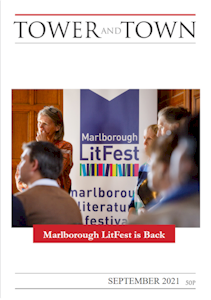

Tower and Town, September 2021 (view the full edition) (view the full edition)Gathering And StoringSeptember marks the start of Autumn, the return to school, shorter days and subtle changes in the natural world. As harvesting ceases the outlines of the countryside shrink, there's a chill in the air and the smells of damp leaves and burning garden rubbish waft across our pathway. In the spirit of Richard Mabey's Food for Free we like to come back from a country walk with a crop of blackberries in a hat or a handkerchief: some strains are fat and juicy, the location of which we keep quiet about. My wife forbids me to pick our local mushrooms ever since I brought half a dozen home and had food poisoning as a result: again, there are those fields which neighbours boast about, but never quite direct you to. There are ripe apples and pears to be picked in the larger gardens, and in the countryside crab apples and so-called 'wilding apples', created when a discarded core has born fruit by the side of the road. Sloes we are told should always be picked after the first frosts, but many are gathered earlier and put in the freezer to crack the skin: the connoisseur will say the flavour is not as good. Prickly horse chestnuts drop from the trees, especially in windy conditions. In my day we picked them, pressed them underfoot and then polished and hardened them up, before stringing them ready to do battle in playground contests now frowned upon by school authorities. Ripening nuts are important to a number of birds and animals preparing for the winter months. Acorns, which fall off the parent tree from September to late October, are an important food source for the jay, which spends as much as ten hours a day caching acorns and other nuts, storing as many as 5,000 during a season. The nuthatch is another hoarder, its name derived from its habit of tucking away nuts into tree-bark and then hacking (thus 'hatching') away at them with its sharp bill. Squirrels will cache peanuts, hazelnuts and walnuts to eat when food is scarce, whilst a dormouse eats as much as it can in order to build up a fat store: before hibernation it makes a nest deep in a hedge or on the ground, lines it with grass, wool and leaves, and prepares a store of food in case it wakes up during a warm spell.  Doormouse in Hibernation Robin Nelson |